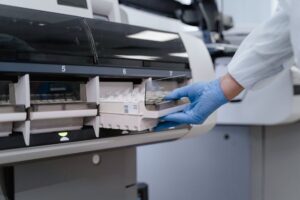Introduction
CRISPR-Cas9 is a revolutionary gene-editing technology that has taken the world of biotechnology by storm. This groundbreaking tool allows scientists to make precise changes to the DNA of living organisms, paving the way for significant advancements in medicine, agriculture, and numerous other fields. As we delve into the intricacies of CRISPR and its implications for the future, it becomes evident that we are on the brink of a new era in genetic engineering.
What is CRISPR-Cas9?
Definition and Origin
CRISPR, which stands for Clustered Regularly Interspaced Short Palindromic Repeats, is a natural defense mechanism found in bacteria. These organisms use CRISPR sequences to remember and combat viral invaders. The CRISPR-Cas9 system, adapted from this natural process, has been harnessed by scientists to edit genes with unprecedented accuracy and efficiency.
How It Works
The CRISPR-Cas9 system operates like a pair of molecular scissors. It consists of two main components: the Cas9 enzyme and a guide RNA. The guide RNA is designed to match a specific DNA sequence, directing the Cas9 enzyme to the precise location in the genome where a cut is needed. Once the DNA is cut, the cell’s natural repair mechanisms kick in, allowing for targeted modifications.
The History of Gene Editing
Early Methods of Gene Editing
Before CRISPR, gene editing was a cumbersome and less precise process. Techniques like zinc finger nucleases (ZFNs) and transcription activator-like effector nucleases (TALENs) were used, but they were time-consuming and expensive.
The Discovery of CRISPR
The discovery of CRISPR’s potential as a gene-editing tool can be traced back to the 1980s and 1990s when researchers first identified these sequences in bacterial genomes. However, it wasn’t until 2012 that scientists, including Jennifer Doudna and Emmanuelle Charpentier, demonstrated CRISPR-Cas9’s ability to cut DNA at specific sites, revolutionizing the field of genetics.
Mechanism of CRISPR-Cas9
Detailed Explanation of the Process
The CRISPR-Cas9 system works through a simple yet elegant process. The guide RNA, which is complementary to the target DNA sequence, binds to the Cas9 enzyme. This complex then scans the genome for the matching sequence. Upon finding the target, Cas9 makes a double-strand cut in the DNA. This break can then be repaired by the cell’s repair machinery, either by non-homologous end joining (NHEJ) or homology-directed repair (HDR), allowing for precise gene modifications.
Components Involved
- Guide RNA (gRNA): A custom RNA sequence that directs Cas9 to the target DNA.
- Cas9 Enzyme: A protein that acts as molecular scissors to cut the DNA.
- Target DNA: The specific sequence in the genome to be edited.
Applications in Medicine
Genetic Disease Treatment
One of the most promising applications of CRISPR is in treating genetic disorders. Diseases like cystic fibrosis, sickle cell anemia, and muscular dystrophy, which are caused by specific genetic mutations, can potentially be cured by correcting these mutations at the DNA level using CRISPR.
Cancer Therapy
CRISPR is also being explored in cancer treatment. By targeting and modifying genes that cause cancerous growths, scientists hope to develop more effective and personalized cancer therapies.
Organ Transplantation
CRISPR could revolutionize organ transplantation by making animal organs suitable for human use. By editing out genes that cause immune rejection, researchers aim to create organs that can be safely transplanted into humans, addressing the critical shortage of donor organs.
Applications in Agriculture
Crop Improvement
In agriculture, CRISPR is being used to develop crops that are more nutritious, resistant to pests and diseases, and tolerant of harsh environmental conditions. For example, researchers have created rice varieties that are resistant to bacterial blight and wheat that is resistant to powdery mildew.
Pest Resistance
By editing the genomes of crops, scientists can make them resistant to pests, reducing the need for chemical pesticides and contributing to sustainable farming practices.
Livestock Enhancement
CRISPR can also be applied to improve livestock. Traits such as disease resistance, increased productivity, and better meat quality can be achieved through precise genetic modifications.
Environmental Applications
Gene Drives for Controlling Invasive Species
CRISPR-based gene drives are being developed to control invasive species that threaten ecosystems. By spreading a genetic modification through a population, it is possible to reduce or eliminate invasive species, helping to preserve biodiversity.
Conservation Efforts
CRISPR is also being used in conservation to help protect endangered species. By enhancing genetic diversity or introducing beneficial traits, scientists aim to bolster populations of endangered animals and plants.
Ethical Considerations
Human Gene Editing
The prospect of editing human genes raises significant ethical questions. While the potential to cure genetic diseases is promising, there are concerns about the unintended consequences and the possibility of “designer babies,” where genetic traits are selected for non-medical reasons.
Germline Modification
Editing the germline—genes that are passed on to future generations—adds another layer of ethical complexity. Changes made to germline cells can have far-reaching and potentially irreversible impacts on the human gene pool.
Consent and Accessibility
Ensuring informed consent and equitable access to CRISPR technologies is crucial. There is a risk that these powerful tools could be accessible only to the wealthy, exacerbating existing inequalities.
CRISPR in Research
Advancing Scientific Understanding
CRISPR is a powerful tool for basic research. It allows scientists to create precise gene knockouts and study the function of specific genes, advancing our understanding of genetics and cellular processes.
Creating Model Organisms
CRISPR has simplified the creation of model organisms that mimic human diseases. These models are invaluable for studying disease mechanisms and testing new treatments.
Functional Genomics
By enabling the targeted manipulation of genes, CRISPR has revolutionized the field of functional genomics. Researchers can now systematically study the roles of genes in health and disease.
Regulatory Landscape
Global Regulatory Frameworks
The regulatory landscape for CRISPR varies worldwide. Some countries have embraced the technology, while others have imposed strict regulations to address ethical and safety concerns.
Policies and Guidelines
International bodies and national governments are developing policies and guidelines to ensure the safe and ethical use of CRISPR. These include standards for laboratory practices, clinical trials, and environmental release.
Case Studies of Regulation
Case studies from countries like the United States, China, and the European Union highlight the diversity of regulatory approaches and their impact on CRISPR research and applications.
Challenges and Limitations
Off-Target Effects
One of the primary challenges of CRISPR is the risk of off-target effects, where unintended parts of the genome are edited. Researchers are developing methods to improve the precision and reduce these unwanted changes.
Delivery Mechanisms
Effectively delivering the CRISPR components to target cells remains a significant hurdle. Various delivery methods, including viral vectors and nanoparticles, are being explored to enhance efficiency and safety.
Ethical and Social Challenges
Beyond technical challenges, CRISPR faces ethical and social hurdles. Addressing public concerns, ensuring responsible use, and navigating the complex ethical landscape are critical for the technology’s acceptance and success.
Future Prospects
Advances in CRISPR Technology
Continuous advancements in CRISPR technology are expanding its capabilities. Innovations like base editing and prime editing offer even more precise and versatile genetic modifications.
Potential Future Applications
The future of CRISPR is bright, with potential applications ranging from curing genetic diseases and creating sustainable agriculture to developing new materials and biofuels.
Predictions for the Next Decade
In the next decade, we can expect CRISPR to become more integrated into healthcare, agriculture, and industry. As the technology matures, its applications will become more diverse and impactful.
Public Perception and Engagement
Public Opinion on Gene Editing
Public perception of gene editing is mixed. While there is excitement about its potential, there are also fears about ethical implications and unintended consequences. Public engagement and education are essential to address these concerns.
Educational Initiatives
Educational initiatives are crucial for fostering an informed public. By providing accurate information and addressing misconceptions, these programs can build trust and support for CRISPR.
The Role of Media
The media plays a significant role in shaping public perception of CRISPR. Responsible reporting and highlighting both the benefits and risks can help create a balanced understanding of the technology.
Economic Impact
Biotechnology Industry Growth
CRISPR is driving significant growth in the biotechnology industry. Startups and established companies alike are investing heavily in CRISPR research and applications.
Investment Trends
Investment in CRISPR technology is on the rise, with venture capital firms, governments, and private investors recognizing its potential to transform multiple sectors.
Market Potential
The market potential for CRISPR is vast, with applications in healthcare, agriculture, environmental management, and beyond. As the technology continues to evolve, its economic impact will only grow.
Conclusion
CRISPR-Cas9 is more than just a scientific breakthrough; it is a catalyst for a new era in biotechnology. Its ability to make precise genetic modifications holds the promise of curing diseases, improving agriculture, and addressing environmental challenges. However, with great power comes great responsibility. Ethical considerations, regulatory frameworks, and public engagement will play crucial roles in shaping the future of CRISPR. As we stand on the cusp of this genetic revolution, the possibilities are boundless, and the journey has just begun.




